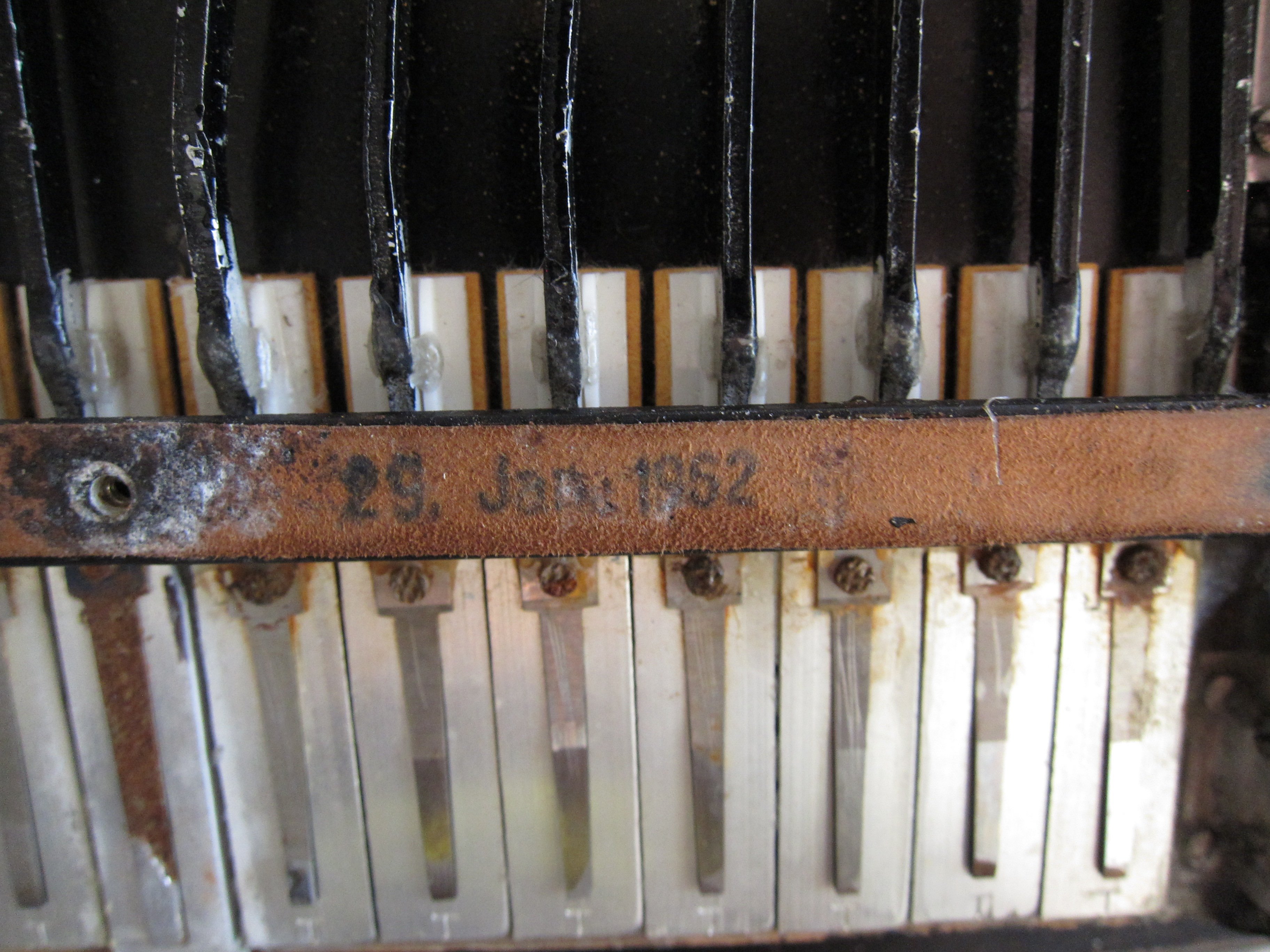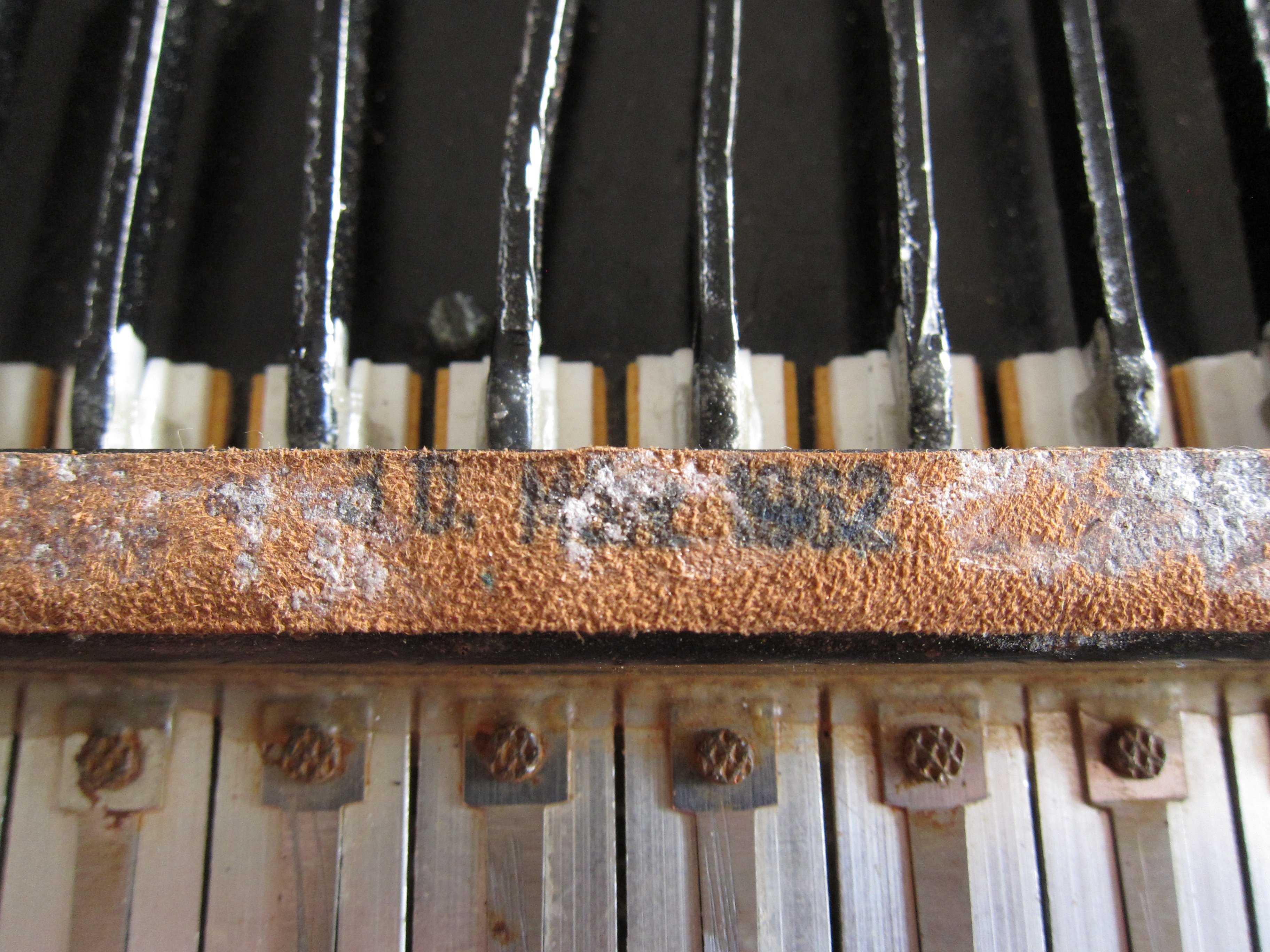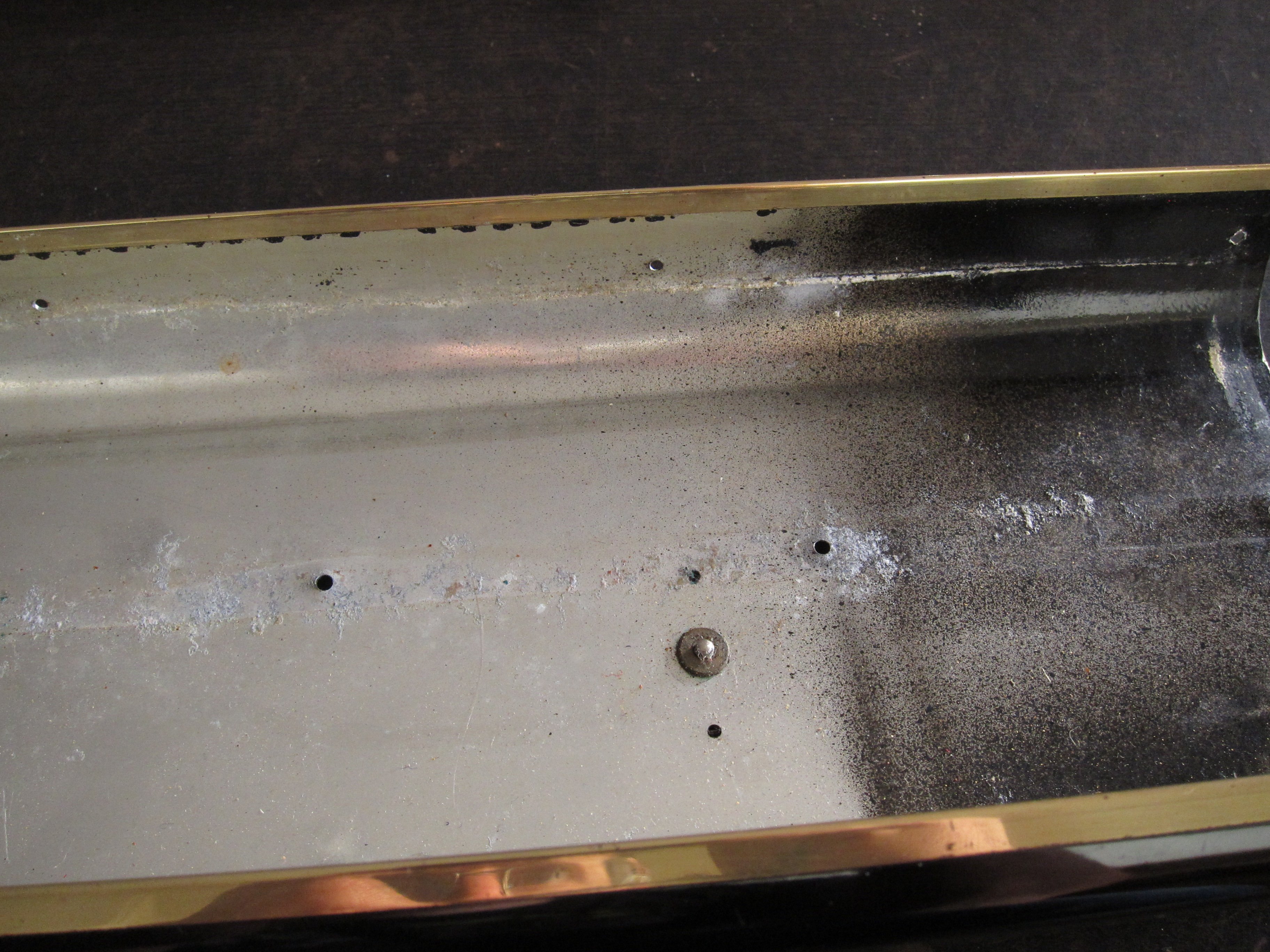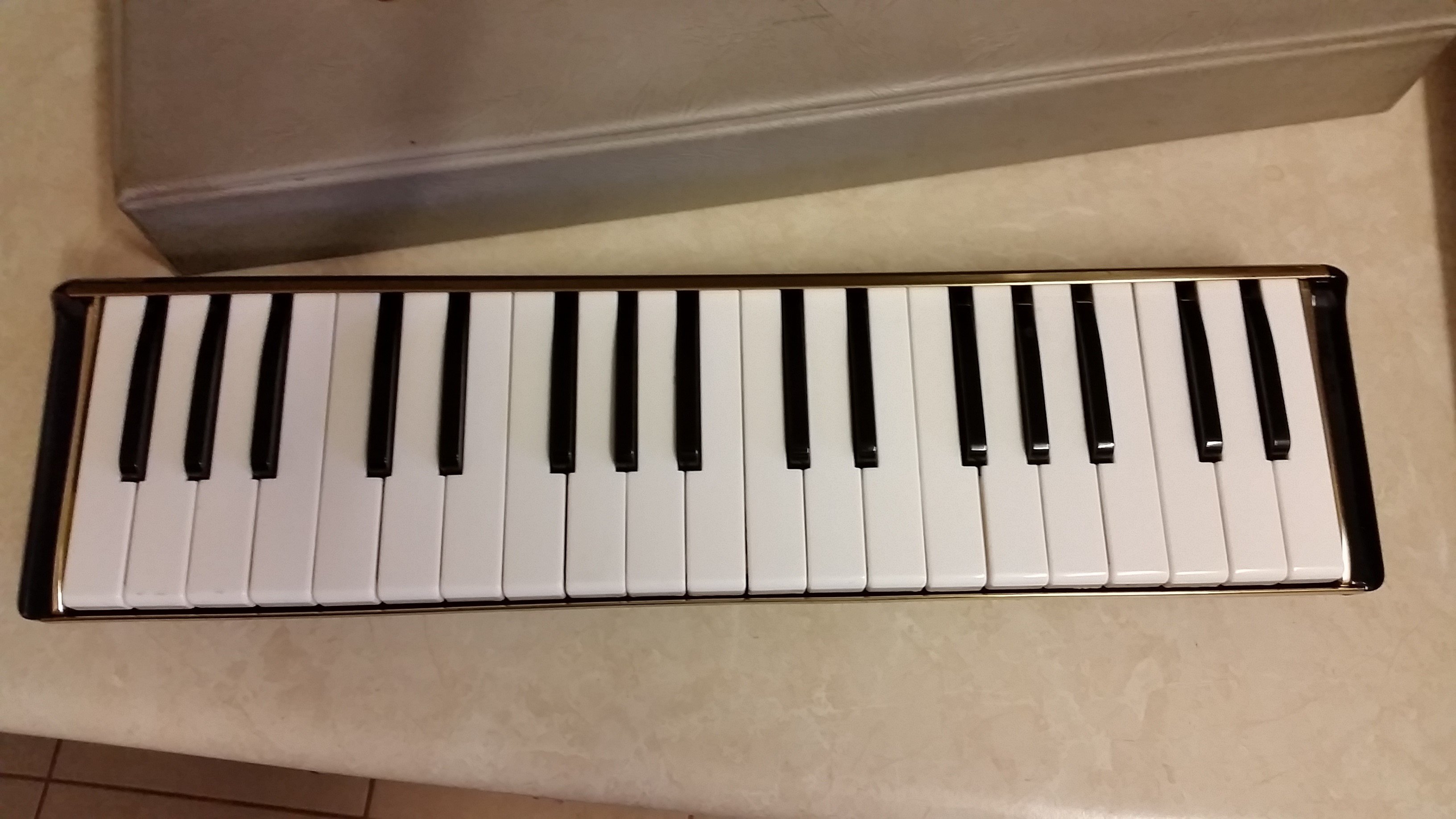My new Pro36
Tagged: hohner professional 36 repair
- This topic has 27 replies, 5 voices, and was last updated 8 years, 12 months ago by
 Melodica-Me.
Melodica-Me.
-
AuthorPosts
-
April 27, 2015 at 9:33 pm #4847
 OfirParticipant
OfirParticipantAfter not that long time (considering the distance it traveled), and too long time (considering the postal promise), my ‘new’ Pro 36 has arrived.
As it was bought by a reliable person, it looks exactly like the pictures.
My first impression is that its (promised to exist) leak makes it completely unplayable. I can hardly say anything about its tone, as roughly 50% of my air goes behind the reeds.As a (not surprising) result, I opened the Pro 36 to inspect its inside. Lack of pictures of the inside of a Pro 36 over the internet made me even more curious to see it naked.
Here you can clearly see that the lowest C reed was replaced

View of most of the instrument

It has time signatures. May it be dates tunings made by Hohner?
The earliest is dated to Jan 1952. This is an old lady!

Here you can see that someone put glue where it was originally wax (am I right here?)

And now to the cover itself, getting to the point where I wish to consult with you guys
 April 27, 2015 at 9:47 pm #4848
April 27, 2015 at 9:47 pm #4848 OfirParticipant
OfirParticipantAs said before, it’s leaking air.
I can spot some suspects:
* worn out sealing of the air chamber.
* missing sealing material (glue?) around the reeds
* keyboard side clampsI must say that the keyboard side clamps seem in a great condition. Also, sealing around the reeds seems good and it is hard to spot any issues. Therefore My first guess would be the outside sealing of the air chamber.
I was thinking of getting a sealing rubber stripe, and to put it on the back-cover side so the screws will press it against the air chamber walls. Was there such sealing originally, or was it only relying on the instrument-side sealing against the metal back-cover? Do you have a suggested product for that purpose?One more thing that I must do, is to replace all the outside screws to Phillips head screws. I simply hate working with old slot head screws! The variety of screws which came with it shows that they were probably replaced over the years. In order not to harm the instrument, do you have a suggestion of how to choose the new screws? The ‘important’ ones (related to the functionality of the instrument) are all screwed into metal holes. I also suspect that some of the screws came with it are simply not tight enough in their holes.
April 28, 2015 at 12:58 am #4849 Melodica-MeParticipant
Melodica-MeParticipantOfir, from your picture of the reed section, I can tell you that you are missing the gasket at the edge by the T on the reed edge. It should be black almost like a felt foam material. Also if you look good at the text it should reed 1962 and not 1952 No Pro-36’s were made in the 50’s. Plus one of your reeds is completely rusted. I would not scrape it but use a Petroleum jelly or squeeze some lemon juice on it, let it sit for a while and wipe carefully. There are some pictures of how I used window gasket in place of the leather and foam, it work better, bulky but reduced at least 95% of the leaks from the reed chamber just with that change.
Melodica-Me
April 28, 2015 at 1:14 am #4850 Alan BrintonParticipant
Alan BrintonParticipantThat rusty looking reed appears to be the one that was replaced with an accordion reed — recently, so that the coating is surprising. Accordion reeds have been (it has been said here) made of various kinds of metal, some of which are much more susceptible to corrosion. Melodica-Me’s advice about that reed seems sensible. It might be more important to do something to stop the corrosion, as opposed to trying to clean it off, especially if the reed is still sounding okay. There has been some discussion here about possible coatings to prevent reed corrosion. I have a product called SMT Synthetic Metal Treatment, which I bought thinking I might try coating reeds with it, but I have not yet tried that.
April 28, 2015 at 6:27 am #4855 OfirParticipant
OfirParticipantAs for the missing gasket, there are gaskets on all 4 sides (of this 3d bended rectangle) of the air chamber. However, it seems to be old and very thin. When claiming that there is, I’m focusing on the lines below the screws on the long edge, and on the bended lines on the top / bottom of the keyboard range.
Melodica-Me, if I misunderstood the location you spotted, please correct me.
Also, can you please link me to a preferred type of window gasket to use?As for the rusty reed, Alan is right and it is the accordion reed that was replaced. Following Adam’s posts in this forum I go back to as early as the end of 2014 as the time of the fix. I have a strong reasons to believe that it was rusty before it was installed:
1. No rust can develop that aggressively on less than 6 months, unless it was stored INSIDE the ocean.
2. There is added material on the reed (I believe that the repairman added it) to match the pitch; this added material COVERS the rust. This reed seems like a sloppy job of the repairman.
Should I worry about this (pre-installed) rust affecting the rest of the materials in it? I don’t think that this actual reed can get more rusty, therefore I’m not sure if I worry for it.
As for the year, I was also surprised to find 52 and not 62. Yesterday evening with artificial light it did look like a solid 5, with the straight lines on the left and on top. This morning, using natural light, it has just became 10 years younger..
Finally, a pic of the beauty (credited to Adam).
 April 28, 2015 at 1:27 pm #4858
April 28, 2015 at 1:27 pm #4858 Adam TombsParticipant
Adam TombsParticipantWithout disputing any of Ofir’s information listed above. I can say that I saw the reed when it was first installed and it was rust free. I never opened it after then. I submit that it may be made of high carbon steel, which will rust and as Melodica me suggests, can be treated with lemon juice to develop a patina, which will resist rust.
As far as the melodica under the sea, I live in a sea port that has very high levels of humidity. That may be the rust origin.
Seal it and perhaps exchange the rusty reed.April 28, 2015 at 1:52 pm #4860 Alan BrintonParticipant
Alan BrintonParticipantIn an accordion, it would not be subject to moisture as melodica reeds are. Maybe there’s also salt in the moisture in the air where you are, Adam.
When you were dealing with the failed reed, Adam, did you consider whether it might be possible to use a reed cut out of a reed plate of a Piano 36? The individual reed plates on the Professional are awfully thick, though.
April 28, 2015 at 3:13 pm #4862 Adam TombsParticipant
Adam TombsParticipantTo be honest Alan, I am a little surprised at how much corrosion is on the reed. Considering that I stored it with all the rest of my instruments and I played it very little ( I use and abuse my melodyhorn as my every day ‘ride’).
It is humid where I live, close enough to the ocean for the fog to roll in occasionally, so my bodhran (frame drums) and stringed instruments always require tuning every time I pick them up to play. I think this is something different however as none of my other instruments are so affected, I doubt the salt air could do this, it may be a reaction between the new reed and the base…. which I think is some kind of alloy.
The Piano 36 reeds are totally different to the Pro 36 reeds, I think it would be easier to source a wrecked Pro 36 and use it as parts than try to modify it to take a Piano 36 reed.
April 28, 2015 at 5:34 pm #4871 OfirParticipant
OfirParticipantAdam, when I wrote about the reed being rusty when installed, I simply thought that you didn’t see the finalized work. I would never suspect that you knew the condition of this reed and didn’t tell. Also, the amount and depth of rust really seems like the result many years. It really looks like the added material was put on the rust, it is THAT deep.
If there was no rust on it roughly 6 months ago, then this reed must go.
April 28, 2015 at 6:32 pm #4875 Melodica-MeParticipant
Melodica-MeParticipantHello Ofir, I attached a site where the pictures are of the Gasket. This is basic window gasket it looks thick but when you squeeze it, it get very small and flat. Notice I did not place it on the actual melodica but on the the metal back. I found this to be better to replace when needed and it works great. I removed all the old gasket material as it was way to old. I purchased this Pro-36 for parts and decided to see if I could make it work for practice. I have a couple of small leak at the pads that I will have to repair sometime. There are much smaller gasket material available. This one was readily available in my garage LOL.
Melodica-Me
http://s355.photobucket.com/user/BigPwr/library/Hohner%20Pro%2036%20Gasket
April 28, 2015 at 6:48 pm #4876 OfirParticipant
OfirParticipantThank you for these pictures! I may try to avoid removing the brown (dated) gasket, and see if it works with it.
I was also thinking of putting it on the metal cover, so we agree on the tactics.As for the rusty reed, do you know of a good place where I can purchase a (good sounding, size matching, non corrosive) replacement? I’m sure that I can approach local accordion repairmen, but I doubt it that they’ll be able to find something which matched to all 3 requirements.
April 28, 2015 at 6:58 pm #4877 Melodica-MeParticipant
Melodica-MeParticipantThe brown original gasket I had was leaking from a lot of areas, so I decided to just eliminate it. I do not know of any other source, I went to the accordion repair man near my office and they made a reed for my Vibrandoneon. the first one they made was almost perfect, the second one was softer in volume but almost exact in tone. I am trying to replace my C5 reed. I noticed from your pictures that it looks like a lot of calcium build-up (white power stuff) or is that something else. I have never seen this before in a Melodica.
Melodica-MeApril 28, 2015 at 7:09 pm #4878 OfirParticipant
OfirParticipantAs for the white powder, it seems to be on the leather (dated) gasket only. It may be salt(?) caused by a salty air, which may also explain the extremely fast rust.
I’ll follow your suggestion and remove it for sealing.
Do you know if accordion repairmen are aware of the need to operate at a humid reed?
(it’s a bad question because your repairman is not mine, but it’s a long shot for using your experience)April 28, 2015 at 7:30 pm #4880 Melodica-MeParticipant
Melodica-MeParticipantActually the question never came up because he replaced it with the same material, He did remove some mold that was starting to grown near the base of the pipe. Not much to be a concern for a 10 year old Vibrandoneon, he brushed some scented bleach with a paint brush and it took care of it in about 30 seconds. He knew that moisture was an issue at that point.
April 28, 2015 at 7:42 pm #4882 OfirParticipant
OfirParticipantDo you know which material is used for the Pro 36 reeds? Must I say that the rest of the reeds look fantastic for a 53 yo instrument.
It does seem like a very quick repair, having the right reed. In my case, the housing of this reed was also replaced, which may make it more difficult to restore, if finding the right reed. -
AuthorPosts
- You must be logged in to reply to this topic.
